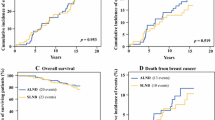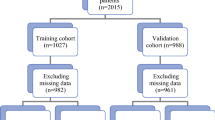Abstract
Background
This study aims to determine the prevalence and predictive factors for recurrence after sentinel lymph node biopsy (SLNB) and for sentinel lymph node positivity by SLNB in our population.
Methods
We followed up all SLNBs performed between 2002 and 2010 and analyzed data by R (version2.10.1), considering p < 0.05 significant.
Results
Among 1,050 patients with SLNB, 23% (245/1050) underwent secondary axillary dissection (CALND). Axillary recurrence prevalence among patients with negative SLNB was 1% (6/805) at a mean follow-up of 54 months (±14), and 1.7% (95% CI 0.2–3.1%) after 6 years of follow-up, as all recurrences developed between the 3rd and the 6th years of follow-up. By multivariate analysis, axillary recurrence results correlated with large tumor size, high number of excised nodes, lymphovascular invasion, high grading, multifocality, Her-2 positivity, intraductal histology, and comedo-like necrosis. Moreover, SLNB positivity results correlated with young age, large tumor size, high number of excised nodes, negative history for second primary malignancies, lymphovascular invasion, and high grading.
Conclusions
Cancer characteristics represent important predictive factors for SLNB positivity, as well as for axillary recurrence in patients with negative SLNB, independently, by surgical and nonsurgical treatment. Therefore, cancer biological behavior and the patient’s hormonal profile should be evaluated with care to better tailor the follow-up of women with breast cancer.




Similar content being viewed by others
References
Rescigno J, Zampell JC, Axelrod D (2009) Patterns of axillary surgical care for breast cancer in the era of sentinel lymph node biopsy. Ann Surg Oncol 16:687–696
Johnson MT, Guidroz JA, Smith BJ et al (2009) A single institutional experience of factors affecting successful identification of sentinel lymph node in breast cancer patients. Surgery 146:671–676 discussion 676–677
Dauphine C, Nemtsev D, Rosing D et al (2010) Axillary recurrence after sentinel lymph node biopsy for breast cancer. Am Surg 76:1127–1129
Cyr A, Gillanders WE, Aft RL et al (2010) Micrometastatic disease and isolated tumor cells as a predictor for additional breast cancer axillary metastatic burden. Ann Surg Oncol 17(Suppl 3):303–311
Krag DN, Anderson SJ, Julian TB et al (2010) Sentinel-lymph-node resection compared with conventional axillary-lymph-node dissection in clinically node-negative patients with breast cancer: overall survival findings from the NSABP B-32 randomised phase 3 trial. Lancet Oncol 11:927–933
Giuliano AE, McCall L, Beitsch P et al (2010) Locoregional recurrence after sentinel lymph node dissection with or without axillary dissection in patients with sentinel lymph node metastases: the American College of Surgeons Oncology Group Z0011 randomized trial. Ann Surg 252:426–432 discussion 432–433
Iannace C, Libero LD, Lepore M et al (2010) Prognostic and curative value of sentinel node in breast cancer. A 377 patients experience. Ann Ital Chir 81:103–111 discussion 112–113
Degnim AC, Zakaria S, Boughey JC et al (2010) Axillary recurrence in breast cancer patients with isolated tumor cells in the sentinel lymph node [AJCC N0(i+)]. Ann Surg Oncol 17:2685–2689
Kim HJ, Son BH, Lim WS et al (2010) Impact of omission of axillary lymph node dissection after negative sentinel lymph node biopsy: 70-month follow-up. Ann Surg Oncol 17:2126–2131
Sampol C, Giménez M, Torrecabota J et al (2010) Axillary recurrences after sentinel lymph node biopsy in initial breast cancer. Rev Esp Med Nucl 29:241–245
Sanli I, Lemaire BMD, Muller AJ et al (2009) Axillary recurrence after negative sentinel lymph node biopsy: frequency and factors influencing recurrence on the long term. Breast J 15:236–241
Kiluk J, Ly Q, Meade T et al (2009) Axillary recurrence rate following negative sentinel node biopsy for invasive breast cancer: long-term follow-up. Ann Surg Oncol 17:552–557
Heuts EM, van der Ent FWC, Hulsewé KWE et al (2008) Incidence of axillary recurrence in 344 sentinel node negative breast cancer patients after intermediate follow-up. A prospective study into the accuracy of sentinel node biopsy in breast cancer patients. Acta Chir Belg 108:203–207
Palesty JA, Foster JM, Hurd TC et al (2006) Axillary recurrence in women with a negative sentinel lymph node and no axillary dissection in breast cancer. J Surg Oncol 93:129–132
Torrenga H, Fabry H, van der Sijp JRM (2004) Omitting axillary lymph node dissection in sentinel node negative breast cancer patients is safe: a long term follow-up analysis. J Surg Oncol 88:4–7 discussion 7–8
Bilimoria KY, Bentrem DJ, Hansen NM et al (2009) Comparison of sentinel lymph node biopsy alone and completion axillary lymph node dissection for node-positive breast cancer. J Clin Oncol 27:2946–2953
Langer I, Guller U, Hsu-Schmitz SF et al (2009) Sentinel lymph node biopsy is associated with improved survival compared to level I & II axillary lymph node dissection in node negative breast cancer patients. Eur J Surg Oncol 35:805–813
Canavese G, Catturich A, Vecchio C et al (2009) Sentinel node biopsy compared with complete axillary dissection for staging early breast cancer with clinically negative lymph nodes: results of randomized trial. Ann Oncol 20:1001–1007
Veronesi U, Galimberti V, Paganelli G et al (2009) Axillary metastases in breast cancer patients with negative sentinel nodes: a follow-up of 3548 cases. Eur J Cancer 45:1381–1388
Sun JY, Ning LS (2008) Axillary skip metastases in breast cancer. Zhonghua Zhong Liu Za Zhi 30:352–355
Kim HJ, Son BH, Park EW et al (2009) Axillary recurrence after negative sentinel lymph node biopsy. Breast Cancer Res Treat 114:301–305
Murray KL, Lambah PA, Anderson TJ et al (2002) Occult lymph node metastases in patients with “node negative” breast carcinoma treated with conservation surgery and axillary node sample and who subsequently developed axillary recurrence. Breast 11:249–251
Schneebaum S, Stadler J, Cohen M et al (1998) Gamma probe-guided sentinel node biopsy—optimal timing for injection. Eur J Surg Oncol 24:515–519
Borgstein PJ, Pijpers R, Comans EF et al (1999) Sentinel lymph node biopsy in breast cancer: guidelines and pitfalls of lymphoscintigraphy and gamma probe detection. J Am Coll Surg 186:275–283
Verkooijen HM, Chatelain V, Fioretta G et al (2007) Survival after bilateral breast cancer: results from a population-based study. Breast Cancer Res Treat 105:347–357
Gauthier T, Mollard J, Fermeaux V et al (2009) Axillary recurrence after negative sentinel lymph node biopsy under local anesthesia in breast cancer. Eur J Surg Oncol 35:464–468
Mustac E, An-Ilijaâ KM, Marijic B et al (2009) Predicting the likelihood of additional nodal metastases in breast carcinoma patients with positive sentinel node biopsy. Int J Surg Pathol 18:36–41
Chen JJ, Huang XY, Liu ZB et al (2009) Sentinel node biopsy and quality of life measures in a Chinese population. Eur J Surg Oncol 35:921–927
Helms G, Kühn T, Moser L et al (2009) Shoulder-arm morbidity in patients with sentinel node biopsy and complete axillary dissection—data from a prospective randomised trial. Eur J Surg Oncol 35:696–701
Natarajan S, Taneja C, Cady B (2005) Evolution of lymphadenectomy in surgical oncology. Surg Oncol Clin N Am 14:447–459
Winchester DP, Trabanino L, Lopez MJ (2005) The evolution of surgery for breast cancer. Surg Oncol Clin N Am 14:479–498
Takács T, Paszt A, Szentpáli K et al (2008) Importance of sentinel lymph node biopsy in surgical therapy of in situ breast cancer. Pathol Oncol Res 15:329–333
Gurleyik G, Gurleyik E, Aker F et al (2007) Lymphovascular invasion, as a prognostic marker in patients with invasive breast cancer. Acta Chir Belg 107:284–287
Weaver DL, Ashikaga T, Krag DN et al (2011) Effect of occult metastases on survival in node-negative breast cancer. N Engl J Med 364:412–421
Cote R, Giuliano AE, Hawes D et al. (2010) ACOSOG Z0010: a multicenter prognostic study of sentinel node (SN) and bone marrow (BM) micrometastases in women with clinical T1/T2 N0 M0 breast cancer. J Clin Oncol (Meeting Abstracts) 28(18S):CRA504
Pazaiti A, Fentiman IS (2011) Which patients need an axillary clearance after sentinel node biopsy? Int J Breast Cancer 2011 Article ID 195892
Tjan-Heijnen VC, Pepels MJ, de Boer M et al (2009) Impact of omission of completion axillary lymph node dissection (cALND) or axillary radiotherapy (ax RT) in breast cancer patients with micrometastases (pN1mi) or isolated tumor cells (pN0[i+]) in the sentinel lymph node (SN): results from the MIRROR study. ASCO Meeting Abstracts 27(18S):CRA506
Leidenius M, Vironen J, Heikkilä P et al (2009) Influence of isolated tumor cells in xentinel nodes on outcome in small, node-negative (pT1N0M0) breast cancer. Ann Surg Oncol 17:252–262
Meretoja TJ, Leidenius MH, Heikkilä PS et al (2009) Sentinel node biopsy in breast cancer patients with large or multifocal tumors. Ann Surg Oncol 16:1148–1155
Ejlertsen B, Jensen MB, Rank F et al (2009) Population-based study of peritumoral lymphovascular invasion and outcome among patients with operable breast cancer. J Natl Cancer Inst 101:729–735
Yagata H, Harigaya K, Suzuki M et al (2003) Comedonecrosis is an unfavorable marker in node-negative invasive breast carcinoma. Pathol Int 53:501–506
Bézu C, Coutant C, Antoine M et al (2009) Feasibility of the sentinel node biopsy in breast cancer in case of histological multifocality diagnosis. Gynecol Obstet Fertil 37:604–610
Veronesi U, Orecchia R, Zurrida S et al (2005) Avoiding axillary dissection in breast cancer surgery: a randomized trial to assess the role of axillary radiotherapy. Ann Oncol 16:383–388
Giuliano AE, Hunt KK, Ballman KV et al (2011) Axillary dissection vs no axillary dissection in women with invasive breast cancer and sentinel node metastasis: a randomized clinical trial. J Am Med Assoc 305:569–575
Pandit TS, Kennette W, Mackenzie L et al (2009) Lymphatic metastasis of breast cancer cells is associated with differential gene expression profiles that predict cancer stem cell-like properties and the ability to survive, establish and grow in a foreign environment. Int J Oncol 35:297–308
Oliveira LR, Jeffrey SS, Ribeiro-Silva A (2010) Stem cells in human breast cancer. Histol Histopathol 25:371–385
Colpaert C, Vermeulen P, Jeuris W et al (2001) Early distant relapse in “node-negative” breast cancer patients is not predicted by occult axillary lymph node metastases, but by the features of the primary tumour. J Pathol 193:442–449
Author information
Authors and Affiliations
Corresponding author
Electronic supplementary material
Below is the link to the electronic supplementary material.
Rights and permissions
About this article
Cite this article
Bernardi, S., Bertozzi, S., Londero, A.P. et al. Nine years of Experience with the Sentinel Lymph Node Biopsy in a Single Italian Center: A Retrospective Analysis of 1,050 Cases. World J Surg 36, 714–722 (2012). https://doi.org/10.1007/s00268-011-1420-0
Published:
Issue Date:
DOI: https://doi.org/10.1007/s00268-011-1420-0




